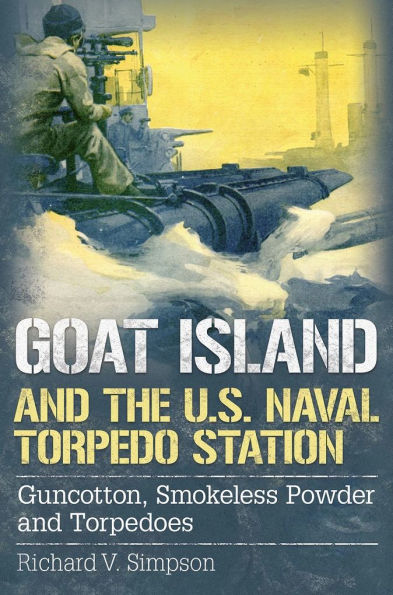Goat Island and the U.S. Naval Torpedo Station: Guncotton, Smokeless Powder and Torpedoes
Traces the evolution of naval torpedoes from Civil War-era innovations to modern weapons research at Newport’s Naval Torpedo Station.
Weak maritime nations have always sought to augment the strength of their coastal defenses and navies by the use of "diabolical" contrivances for destroying an invader's ships.
The history of the adoption of the torpedo as a recognized implement of warfare is not unlike that of gunpowder or of exploding shells. Each in its turn was met by the cry, "Inhuman, barbarous, unchivalrous."
During the American Civil War, the Confederate Navy employed submerged mines, called torpedoes, and explosive charges mounted on a long pole referred to as the "spar torpedo" which was bumped into the hull of an enemy vessel exploding on contact.
These weapons enjoyed great success during the conflict. In July 1869, the Secretary of the Navy announced the establishment of the Naval Torpedo Station on Goat Island in the harbor of Newport, Rhode Island, for development of a more sophisticated and deadlier self-propelled torpedo.
From its founding until the end of the Second World War, the Naval Torpedo Station has been the Navy's principal center for the design of torpedoes.
Newport continues as the home of the U.S. Navy's most important laboratory for research and development of modern weapons' systems.
1124075139
Weak maritime nations have always sought to augment the strength of their coastal defenses and navies by the use of "diabolical" contrivances for destroying an invader's ships.
The history of the adoption of the torpedo as a recognized implement of warfare is not unlike that of gunpowder or of exploding shells. Each in its turn was met by the cry, "Inhuman, barbarous, unchivalrous."
During the American Civil War, the Confederate Navy employed submerged mines, called torpedoes, and explosive charges mounted on a long pole referred to as the "spar torpedo" which was bumped into the hull of an enemy vessel exploding on contact.
These weapons enjoyed great success during the conflict. In July 1869, the Secretary of the Navy announced the establishment of the Naval Torpedo Station on Goat Island in the harbor of Newport, Rhode Island, for development of a more sophisticated and deadlier self-propelled torpedo.
From its founding until the end of the Second World War, the Naval Torpedo Station has been the Navy's principal center for the design of torpedoes.
Newport continues as the home of the U.S. Navy's most important laboratory for research and development of modern weapons' systems.
Goat Island and the U.S. Naval Torpedo Station: Guncotton, Smokeless Powder and Torpedoes
Traces the evolution of naval torpedoes from Civil War-era innovations to modern weapons research at Newport’s Naval Torpedo Station.
Weak maritime nations have always sought to augment the strength of their coastal defenses and navies by the use of "diabolical" contrivances for destroying an invader's ships.
The history of the adoption of the torpedo as a recognized implement of warfare is not unlike that of gunpowder or of exploding shells. Each in its turn was met by the cry, "Inhuman, barbarous, unchivalrous."
During the American Civil War, the Confederate Navy employed submerged mines, called torpedoes, and explosive charges mounted on a long pole referred to as the "spar torpedo" which was bumped into the hull of an enemy vessel exploding on contact.
These weapons enjoyed great success during the conflict. In July 1869, the Secretary of the Navy announced the establishment of the Naval Torpedo Station on Goat Island in the harbor of Newport, Rhode Island, for development of a more sophisticated and deadlier self-propelled torpedo.
From its founding until the end of the Second World War, the Naval Torpedo Station has been the Navy's principal center for the design of torpedoes.
Newport continues as the home of the U.S. Navy's most important laboratory for research and development of modern weapons' systems.
Weak maritime nations have always sought to augment the strength of their coastal defenses and navies by the use of "diabolical" contrivances for destroying an invader's ships.
The history of the adoption of the torpedo as a recognized implement of warfare is not unlike that of gunpowder or of exploding shells. Each in its turn was met by the cry, "Inhuman, barbarous, unchivalrous."
During the American Civil War, the Confederate Navy employed submerged mines, called torpedoes, and explosive charges mounted on a long pole referred to as the "spar torpedo" which was bumped into the hull of an enemy vessel exploding on contact.
These weapons enjoyed great success during the conflict. In July 1869, the Secretary of the Navy announced the establishment of the Naval Torpedo Station on Goat Island in the harbor of Newport, Rhode Island, for development of a more sophisticated and deadlier self-propelled torpedo.
From its founding until the end of the Second World War, the Naval Torpedo Station has been the Navy's principal center for the design of torpedoes.
Newport continues as the home of the U.S. Navy's most important laboratory for research and development of modern weapons' systems.
28.95
In Stock
5
1

Goat Island and the U.S. Naval Torpedo Station: Guncotton, Smokeless Powder and Torpedoes
192
Goat Island and the U.S. Naval Torpedo Station: Guncotton, Smokeless Powder and Torpedoes
192Hardcover
$28.95
28.95
In Stock

Product Details
| ISBN-13: | 9781634990134 |
|---|---|
| Publisher: | Fonthill Media |
| Publication date: | 11/21/2016 |
| Series: | America Through Time |
| Pages: | 192 |
| Product dimensions: | 6.00(w) x 9.30(h) x 0.80(d) |
About the Author
From the B&N Reads Blog
